Tharp's Thoughts Weekly Newsletter (View On-Line)
-
Article Trading at 95%, A Project Marathon Update by R.J. Hixson
-
-
-
Trading Tip A Technical Look at the U.S. Stock Market by D.R. Barton, Jr.
$700 Discount Expires Next Week on
Three-day Forex Systems Workshop
Plus, plan on staying for three more days of individual systems at the
Super Trader Systems Workshop
Learn More....
 Trading at 95%, A Project Marathon Update Trading at 95%, A Project Marathon Update
by R.J. Hixson
At several points during last weekend’s Peak 101 workshop, we talked about measuring system performance. One key idea was that when you violate your systems’ rules or even “make an adjustment” to them, you are no longer executing the system anymore. You may have lots of backtested results for that system, or forward-tested trades, or live trades. The “adjustment” may even yield a better result than your rules would have provided. But once you alter a rule executing a trade, the trade no longer belongs to that system—which means that you can’t use it fairly to measure the system’s performance. It is something else.
We touched on this point again during the mistakes section of the workshop. By Van’s definition, a trading mistake is not following your rules—regardless of whether doing so caused you to lose money or make money on a trade. You can have discretion as part of your trading, but that discretion needs to be managed by rules—when you can apply it, and how much leeway you’re allowed. From Van’s research, most so-called “discretionary” traders have no rules, which means that everything they do is a mistake (at a recent conference in New York, a friend also related that he pressed hard enough on a number of managers who said they had “proprietary” systems only to find out that most of them would qualify as totally discretionary traders who had no real trading systems at all).
Tracking Mistakes
To help monitor the mistakes you make, you can track them. My mistake log is nothing fancy, just a spreadsheet with some basic information—date, trade, kind of mistake, my thoughts on the reason for the mistake, ways to avoid the mistake again, cost of mistake in terms of R-multiples, cost of mistake in terms of dollars, and, my trader efficiency statistic.
Here's a quick example:
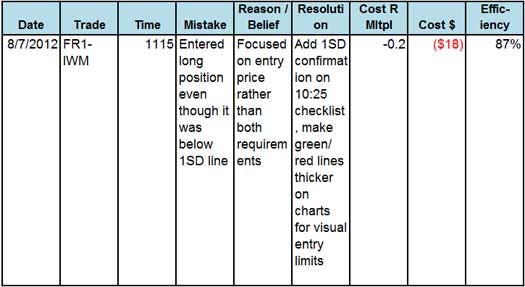
On August 7, I entered a position at 11:15AM. Shortly after entering, I realized that one of the required conditions for entry had not occurred on my charts. Entering without having met that condition was a mistake, one that cost me .2R and $18—not too costly by R-multiple and monetary standards, but it dropped me from 90% efficiency to 87%. I believed that I was so focused on stalking the primary entry criteria that I forgot to check on the secondary requirement. In order to avoid that particular mistake in the future, I took two fairly simple actions: I made the qualifying support lines on my chart much “fatter” so I couldn’t miss them, and I added an item to my 10:25AM checklist about the secondary condition. Those two actions helped keep me from making that mistake again to date.
Tracking my mistakes has been one of the most humbling experiences I have ever undertaken. Other Super Traders say they have had a similar experience. At first, it seemed like I was catching mistakes all the time, to the point that it was almost overwhelming. In time, my trader efficiency level came up and has pretty consistently hovered in the 80%-90% range. That means I have usually made about one mistake every eight to ten trades.
By Van’s standards 80%-90% efficiency is fairly poor and way beneath the potential for Super Traders. One of my goals this year has been to graduate from the Super Trader program. To finish, Van needed to approve three trading systems and I had to trade them at a 95% efficiency level or better for a hundred trades or more. That is, less than five mistakes in one hundred trades.
A New Approach
To finish off this last set of requirements, I stopped trading for the first half of the year to rewrite my plan and submit systems that were good enough for Van to approve. I also realized or created a number of conditions that would help me follow the system rules and minimize (if not eliminate) the chance for making mistakes. Those factors included:
- My primary objective became the perfect execution of my trading systems’ rules. In the past, I was focused more on trying to prove that a system could fit me or on “making money,” but after doing some self-work last year, I realized that “making money” had more to do with my need to “be right” than with actually making money. I realized that if I had good systems and followed their rules, that could be a new way for me to make money.
- I understood the systems very well. I picked three that fit me and that were non-correlated. I’ve traded them or very close versions of them previously and I had a pretty good idea of what to expect in terms of entries, exits, holding periods, etc.
- I had faith in the expectancy of the systems. My primary day trading system is one that Ken Long teaches. I traded it myself last year, and I spoke with a Super Trader who completed over 1,000 trades using the same system. Based on Ken’s ideas, my experience, and the other Super Trader’s trading, I believed entering and exiting when I was supposed to would allow me to realize the expectancy of the system.
- I took the discretion away and just traded the systems with the mechanical rules. Ken refers to the performance measurement of a trader executing a system as the TQN, or the Trader Quality Number. When the TQN < SQN, then the trader is best served by going back to trading the rules without any help (discretion) from the trader.
- I wanted to graduate from the ST program. I really wanted to graduate from the ST program. It was time, and I was committed. I knew I was capable, and I had a very strong desire. Simply focusing on that goal helped me follow my rules.
Approval and Trading and . . .
Van did approve my systems and I started trading again in July with the 95% efficiency goal uppermost in my mind. On the very first trade, I made a mistake. Doh! It was flat-out discouraging, but it was also a valuable lesson. It showed me that I wasn’t familiar enough with my system rules and needed to study them some more—which I did, and I’ve never made that kind of mistake again.
Over the last three months, the mistakes were more frequent early on but I’ve been able to follow my rules very closely, and my mistakes have been overall minimal. In fact, following my rules has been easier than ever in large part to the points I made above. That I maintained a 95% efficiency level and have graduated from the Super Trader program has been almost like a denouement.
Last year, one of our workshop attendees told us about being presented his black belt by the dojo. The sensei said something to the effect of “Now you are a serious beginner” and that’s how I feel today. Time to revisit my objectives and prep for this next phase of trading - which I’ll let you know about in the next article.
About the Author: R.J. Hixson is a devoted husband and active father. At the Van Tharp Institute, he researches and develops new products and services that help traders trade better. He has recently been fascinated at how microorganisms shrink his composting pile volume by more than 50%. He can be contacted at “rj” at “vantharp.com”.
Trading Education
Workshops
November will be our last set of systems workshops in 2012.
$700 Discount Expires Next Week, October 31, on Forex.
Plus our Great Super Trader Systems Workshop offers a unique opportunity to learn three diverse systems back-to-back.
To see the schedule, including dates, prices, combo discounts and location, click here.
Also coming soon, dates for a Peak Performance 101 workshop in January, and February dates for Blueprint for Trading Success and How to Develop A Winning Trading System That Fits You.
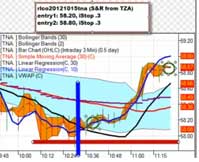 Mini Trading Session Mini Trading Session
If you didn't see this last week, instructor Ken Long would like to share a short video about a 2.3R trade from that week. Thank you Ken!
Click to View Video
Trading Tip 
A Technical Look at the U.S. Stock Market
by D.R. Barton, Jr.
In the U.S., we’re approaching a presidential election in a few weeks and a fiscal cliff in a few months, and the stock market can’t seem to make up its mind about how to move from the recent intermediate highs. In fact, for the last six weeks or so, the market has been in a very tight 3.9% channel. Let’s take a look at some technical clues for direction and touch on some important levels that could tell us when the market has decided to break one way or the other.
More Dollars Chasing the Same Amount of Assets = ???
First, let’s look at the dominant intermediate-term trend. After the May 2012 market swoon, the S&P 500 and other major indices bottomed on the first trading day of June. Since then, we’ve been in a well-defined uptrend, one in which the market has stayed above a trendline that any junior market technician could draw:
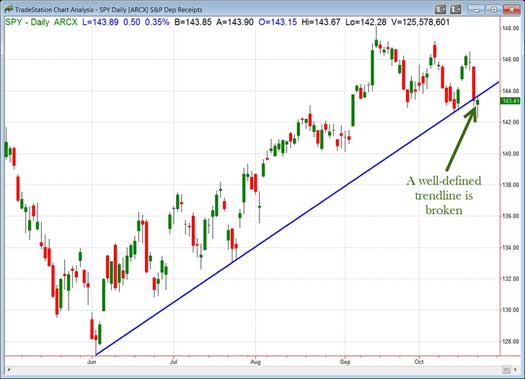
Note, however, that the market action over the last few days has broken this five-month trendline. As a very interesting aside, Friday’s nearly 2% drop in the S&P 500 marked the 25th anniversary of “Black Monday”—October 19, 1987. Though this recent market drop was an order of magnitude smaller than the 1987 plunge, it was still the biggest drop in the last four months.
In addition, price on the S&P 500 reached a six-week low and set up a very interesting downward sloping channel:
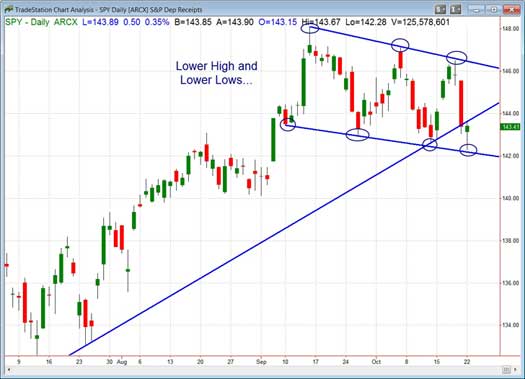
Important Support
This six-week consolidation pattern and broken trendline are really just precursors of the next big move. The broken trendline is fairly significant, but for the bears to confirm they are truly back in control, the market needs to break two levels of upcoming support – the “Draghi Day” low just below 142 and then the 140 zone on the S&P 500 ETF (Symbol: SPY).
Let’s identify the important levels in our chart to round out the full technical picture:
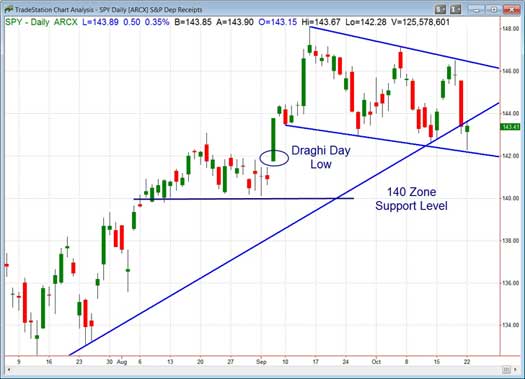
For the bulls, breaking out above the visual channel shown in the last two charts would be the first positive sign, but the bull won’t gain new traction until it closes above the September 14 high and stays there for a couple of days.
Where to From Here?
While the market might look like it has consolidated over the last six weeks, it has actually formed a bearish formation with lower highs and lower lows. The outcome of the presidential and congressional elections in the U.S. will continue to keep the uncertainty factor high and likely keep the market on its sideways path until the election on November 6.
As always, I welcome your comments and feedback. Send them to drbarton “at” vantharp.com
Great Trading, D. R.
About the Author: A passion for the systematic approach to the markets and lifelong love of teaching and learning have propelled D.R. Barton, Jr. to the top of the investment and trading arena. He is a regularly featured guest on both Report on Business TV, and WTOP News Radio in Washington, D.C., and has been a guest on Bloomberg Radio. His articles have appeared on SmartMoney.com and Financial Advisor magazine. You may contact D.R. at "drbarton" at "vantharp.com".
Disclaimer
Ask Van...
Everything we do here at the Van Tharp Institute is focused on helping you improve as a trader and investor. Consequently, we love to get your feedback, both positive and negative!
Click here to take our quick, 6-question survey.
Also, send comments or ask Van a question by clicking here.
Back to Top
Contact Us
Email us at [email protected]
The Van Tharp Institute does not support spamming in any way, shape or form. This is a subscription based newsletter.
To change your e-mail Address, e-mail us at [email protected].
To stop your subscription, click on the "unsubscribe" link at the bottom left-hand corner of this email.
How are we doing? Give us your feedback! Click here to take our quick survey.
800-385-4486 * 919-466-0043 * Fax 919-466-0408
SQN® and the System Quality Number® are registered trademarks of the Van Tharp Institute
Back to Top |